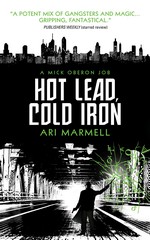 Hot Lead, Cold Iron
Hot Lead, Cold Iron
by Ari Marmell
Trade Paperback, 311 pg.
Titan Books, 2014
Read: May 19 – 27, 2014
This is the way to start a series, I mean, wow. Mick Oberon is a P.I. in the rough and tumble days of late-Prohibition-era Chicago. He mixes with the mob, political figures,and other assorted low-lifes, while eking out a living — just enough to afford milk, rent and the cheap suits he wears. He can take a beating like nobody’s business, and packs a wand rather than rather than a gun. Oh yeah, and he’s fae.
I’ve got a mental checklist that I use to evaluate a new (to me) Urban Fantasy: 1. Is there a strong voice? 2. Do I like the characters/world? 3. Is the magic system interesting? (you can replace vampire/werewolf/etc. system where applicable)
Hot Lead, Cold Iron passes this test easily. Oberon’s smart, snarky — a little disdainful of humanity (but it’s not like you can really disagree with him). This Chicago is right out of The Untouchables, and when you add in the supernatural to the world (plus the Seelie/Unseelie Courts) — this world is a riot. There is so much raw material here that Marmell is set for several books. The magic system? I don’t have it all worked out after just one book, but what I’ve seen, I’ve liked. Oberson plays with luck — he takes good luck from people and uses it to power his own, he magnifies people’s bad luck to cause mishaps/mayhem, and so on. No big fireballs, or dramatic spells, just little bits of luck here and there going his way. I think that’s pretty nifty — especially the way it’s working out so far.
I’ve enjoyed Marmell’s prose in the past, and this is no different, even as it doesn’t feel like his other books. The novel is filled with great lines that are the epitome of hard-boiled P.I.s like Phillip Marlowe or Dixon Hill such as, “clad in shirt and trousers creased sharp enough to trim hedges.” Or this description of the fae world:
The colors. . . They’re intense, impossible, almost painful; entities unto themselves, rather’n mere traits of other objects. They’re stark, standing out against each other, the richest greens, the sharpest reds, the deepest browns, the brightest yellows. you could try to capture ’em in a painting, but nobody’d buy it: too fake-looking. There’s no gradation, nothing muted; the dark and light emeralds of a leaf don’t blend into each other, but sit side-by-side with clear demarcation — as if no one color here would ever lower itself to blend with another.
I hope future books spend more time in the fae world (and there’s every indication that they will), it’s slightly bent/twisted hyper-reality was truly imaginative, and unlike anyone else’s take on it. The fae camera, for example, was sort of a mix of something you’d find in a store on Diagon Alley and in Bedrock. I realize that analogy probably makes no sense — read the book and it will.
Good action, good plot, strong protagonist, strange world and intriguing magic system — everything a series’ first novel needs. Bring on the next!
—–


